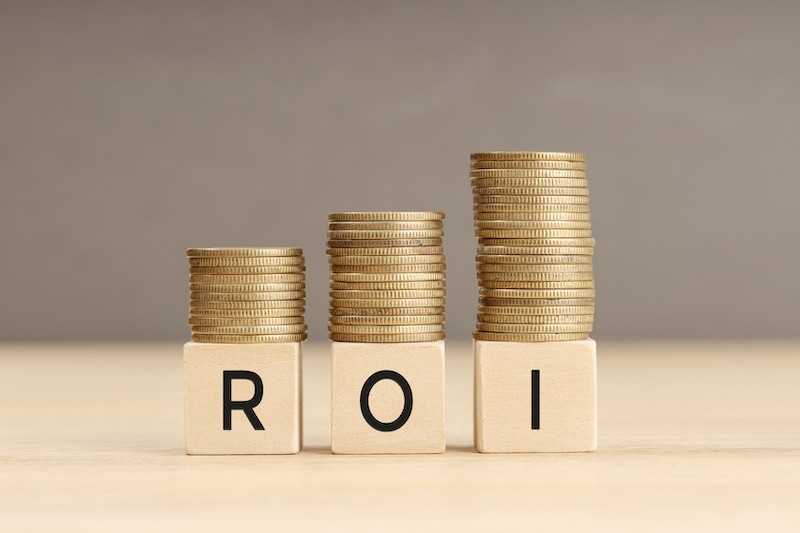After setting up your business and putting your website together, it is important to start bringing people to your website. There are a lot of different ways to do this: through different forms of advertising or through full content marketing campaigns. The next step is making sure that you have the best ROI possible. Focusing on your content marketing ROI can help ensure that you are spending your money wisely and making the best decisions for your business. But first, it’s important to ask: What is ROI in content marketing?
This article will define both ROI and content marketing and a few of the many content benefits, then explain why ROI is important to keep track of in content marketing, as well as how you can calculate ROI for yourself.
What is ROI?
- 1 What is ROI?
- 2 What is Content Marketing?
- 3 Content Benefits for Your Business
- 4 What is a Good ROI For Content Marketing?
- 5 Content Vs PPC ROI
- 6 Content Marketing Pricing
- 7 Getting the Best ROI For Your Campaign
- 8 FAQs about Content Marketing ROI
- 9 1. How long does it take to see ROI from content marketing?
- 10 2. What’s a good ROI percentage for content marketing?
- 11 3. How do I calculate ROI if my content marketing goals aren’t direct sales?
- 12 4. Should I invest in content marketing or PPC advertising for better ROI?
- 13 5. What types of content typically provide the best ROI?
- 14 6. How much should I budget for content marketing?
- 15 7. What are the biggest mistakes that hurt content marketing ROI?
To begin, it is important to dissect what ROI actually is. Without having a solid understanding of ROI, it is nearly impossible to find the right package for your business’s content marketing campaign.
ROI stands for return on investment. It is a mathematical equation that you can use to measure the success of anything you put time, money, and effort into. When it comes to SEO and digital marketing, you can use ROI to see if the money you are spending is paying off. This “payoff” can be whatever you want it to be: increased sales, leads, customer engagement, and more.
It is important to keep track of your ROI in order to keep a strong handle on your business’s finances. Keeping your financial investments worthwhile will lead to greater success, and SEO and marketing are indeed investments. It is easy to assume that once you start paying for content marketing, you will automatically have a good ROI. However, these things do take time. That is why it is so important to have a good understanding of what you are paying for beyond just content marketing pricing, in addition to how to measure your success.
What is Content Marketing?
With an understanding of half of content marketing ROI, now let’s discuss the other half: content marketing itself. Content marketing falls under the umbrella of digital marketing, which is a marketing style that is continuing to grow in popularity almost exponentially. Digital marketing is the work of marketing through any digital technology.
Content marketing focuses specifically on creating unique content for a variety of different channels, such as social media posts, blogs, infographics, videos, and more. The overall goal of this content is to attract and inform, as well as gain new customers. It promotes brand awareness while establishing authority in its field. It is an excellent way of engaging with new and returning customers across different platforms.
The content marketing process takes time to come to fruition. It takes a lot of deliberate and careful planning. High-quality content has to be released consistently and across a few different platforms in order to have the successful outreach that you are hoping for. You can also utilize advertisements like PPC, but we will discuss content vs PPC ROI later on. In the meantime, however, remember that despite the time investment, content marketing can have serious benefits for your business.
Content Benefits for Your Business
Here are some of the great benefits of investing in content marketing ROI for your business:
- Increased Audience Retention: As long as you are creating engaging and informative content, your customers are more likely to stick around! Especially when it comes to social media, the more you can post and engage with your audience, the better. More people will engage with your posts and then become customers, both new and returning.
- Becoming An Authority: An important part of content marketing is being factual and informative. When you cite reputable sources and offer your audience real information, you become an authority on the topic. This means people are going to feel more and more comfortable coming to your content with their questions and needs. You can build trust through your consumer base and become an expert in the field.
- Boosting Brand Awareness: When you use tools like keywords and hashtags through your content, you are actively growing your brand awareness. Engaging content and outreach tactics mean that more people are going to see and even share your content with others. This grows your audience base and offers more opportunities for conversions and leads.
What is a Good ROI For Content Marketing?
If you are starting a business for the first time or freshly learning about ROI, you may be wondering what good ROI looks like in content marketing. Here are a couple of ways to discern if your content marketing campaign is giving you a good ROI for your content marketing pricing:
Benchmarks
Marketing ROI benchmarks are one great way to get an idea of how your ROI looks. Benchmarks are like the guideposts you can use to track your progress along the way. You can track your company’s history in a specific area, like conversion rates or profits, and then compare them to how you are currently doing. Tracking this data across months or years can give you a great indication of how well your content marketing campaign is going.
Measuring ROI
If you are looking to fully measure your marketing ROI, you can use this equation:
Content marketing ROI (%) = ((return – investment)/ investment) x 100
Calculate the amount of sales generated specifically from your content. This number will serve as your return. The amount of money you spend on marketing is going to be your investment number. A good marketing ROI will be a number that yields a higher profit than the cost of producing content.
Content Vs PPC ROI
In addition to just content marketing ROI, you might also consider using PPC as a way to get your content to other people. PPC stands for Pay-Per-Click, which is a form of advertising that operates in a different way than traditional content marketing.
One common form of PPC is Search Engine PPC. This means that different advertisers will bid on keywords that they want in their ads. Then, your website advertisement is displayed when web users search for that keyword. There are a lot of different platforms and ways to do PPC advertising, like through Google Ads.
PPC can give you a high ROI as long as you have the right marketing team on your side. At first glance, the process can seem a lot simpler than going through content marketing campaigns, but it can actually be just as complicated. PPC takes as much strategy and thought as any other type of marketing. The benefits of content marketing and PPC ads are great, but both systems require a lot of work in order to produce a strong return on investment.
Content Marketing Pricing
Now, let’s talk about what pricing typically looks like for content marketing. Because of all of the content benefits you can receive from creating content marketing campaigns, there are some costs attached.
Here are some of the factors that influence content marketing prices:
- Type of Content: The type of content marketing that you want to do is going to affect the pricing. Long-form content like articles and blog posts might cost a little bit more than a social media post, for example.
- Frequency and Volume: Another element that affects cost is going to be how much you want written and in what time frame. The more you want written, and the less time you give for the deadline to pass, the more expensive the cost will be.
- Expertise: Depending on the strength of the company itself, the pricing of content writing and development might fluctuate. The best companies, however, should be able to produce quality content for you while keeping to your budget.
Getting a quote from a few different marketing companies is a smart way to get an idea of what you may be paying. Ideally, you should be able to set your budget and learn about what services you can receive within your price range.
Getting the Best ROI For Your Campaign
One of the best ways to gain success in your marketing campaign is by working with an external content marketing team. Considering all the fine details and work that goes into creating a strong marketing campaign, if you do it all yourself, you are bound to lose time for the other important parts of building a website. With the right marketing team on your side, you can build the best content with an excellent return on investment.
Whether you are debating content vs PPC ROI or are just looking for some help with your analytics, our team at SEO Design Chicago is here to help. We have a highly skilled team of content marketing experts on our side who are eager to help you put together the best content marketing ROI strategy. We make an effort to work within your budget to create a marketing kit that works for you while still accomplishing all of your needs.
FAQs about Content Marketing ROI
1. How long does it take to see ROI from content marketing?
Content marketing typically takes 6-12 months to show significant ROI, as it focuses on building long-term brand authority and audience relationships rather than immediate conversions. Unlike PPC advertising which can generate quick results, content marketing requires consistent, high-quality content published across multiple platforms before you see substantial returns. However, you may notice early indicators like increased website traffic, social media engagement, and brand awareness within the first few months. Patience and consistency are key to maximizing content marketing ROI.
2. What’s a good ROI percentage for content marketing?
A good content marketing ROI is any positive percentage where your returns exceed your investment costs. Many successful content marketing campaigns achieve ROI between 200-400%, meaning for every dollar spent, they generate $2-4 in return. However, “good” ROI varies by industry, business goals, and what you’re measuring (sales, leads, engagement). Focus on whether your ROI is improving over time and beating your benchmarks rather than comparing to arbitrary industry standards. Track your progress monthly and annually to understand your growth trajectory.
3. How do I calculate ROI if my content marketing goals aren’t direct sales?
While the basic ROI formula is ((return – investment) / investment) x 100, you can adapt it for non-sales goals by assigning monetary values to your objectives. For lead generation, calculate the average value of a lead based on conversion rates and customer lifetime value. For brand awareness, track metrics like website traffic, time on site, and social shares, then correlate these to eventual conversions. You can also measure “soft” ROI through engagement rates, email list growth, and content shares, which indicate future revenue potential even if they don’t immediately convert to sales.
4. Should I invest in content marketing or PPC advertising for better ROI?
Both content marketing and PPC can deliver strong ROI, but they work differently. PPC provides faster results and is ideal for immediate lead generation or promoting time-sensitive offers, but costs are ongoing and stop when you stop paying. Content marketing builds long-term value, establishing authority and generating organic traffic that continues even after you stop creating new content, though it takes longer to see results. Most successful strategies use both: PPC for quick wins and testing, content marketing for sustainable growth. Start with your budget, timeline, and goals to determine the right mix.
5. What types of content typically provide the best ROI?
High-performing content types include long-form blog posts and articles that rank well in search engines, video content which has high engagement rates, infographics that are highly shareable, case studies and testimonials that build trust and drive conversions, and email newsletters that nurture leads. However, the “best” content type depends on your audience preferences and business goals. Test different formats, measure their performance, and double down on what resonates with your specific audience. Quality and relevance matter more than format.
6. How much should I budget for content marketing?
Content marketing budgets vary widely based on business size, industry, and goals. Small businesses typically allocate $2,000-$10,000 monthly, while larger companies may spend $20,000-$100,000+ per month. Factors affecting cost include content type and volume (blog posts cost less than professional videos), frequency of publication, level of expertise required, and whether you hire freelancers, an agency, or build an in-house team. Start with what you can afford consistently, then scale up as you see ROI. It’s better to invest in quality content published regularly than to overspend on sporadic high-budget pieces.
7. What are the biggest mistakes that hurt content marketing ROI?
Common ROI-killing mistakes include creating content without a strategy or clear goals, publishing inconsistently or abandoning efforts too early before seeing results, ignoring SEO best practices and keyword research, not promoting content across multiple channels, failing to track and measure performance metrics, creating content that doesn’t address audience needs or pain points, and not repurposing successful content for maximum value. Additionally, many businesses don’t invest in content distribution and promotion, expecting great content alone to generate results. Avoid these pitfalls by developing a comprehensive strategy, tracking metrics religiously, and committing to consistent execution over time.







Contact Us today!